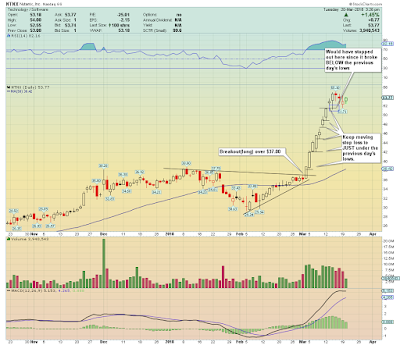I just wanted to share this quick post on one of the techniques i use to stay in winning trades LONGER and truly give those winning trades a chance to run to maximize profits in a logical and methodical manner!
AOT members know that i use the STAIR-STEP Stop loss method regularly and today's i'd like to talk about why I like to move stops to JUST UNDER the previous day's lows once we are in a stock that is working....
So essentially, as long as the trade is working and the stock price is moving HIGHER after breaking out, and it's a swing trade that's working well and market conditions are "favorable" for swing trading, i like to move the stop loss up to just under the previous day's lows and keep walking up the stop UNTIL the stock takes you out.
Obviously, every now and then you're going to get STOPPED OUT prematurely, SURE, no system is perfect!!
....But on some occasions you're going to land on a "home run" trade, where you get a NAIL an entry in a strong momentum stock right as the breakout gets going HARD.....
Let's take that NTNX as a good recent example!
Assume you got into it right as it triggered thru that KEY $37.00 breakout spot!
Trade is working and you keep walking up the stop to just under the previous day's lows so you will essentially stop out when the stock breaks the previous day's lows....
The idea behind this method is, once you NAIL an entry, every now and then, you are on going to land on a sweet trade like that NTNX or that AMD(as a good recent for example)....
So while the mathematical probables are not high to nail many trades in any given single year of that caliber BUT if you land say 2 to 3 trades per month like that NTNX or AMD, you will be ONE HAPPY TRADER! Wouldn't you agree?!
Try using the 'Stair-Step Stop Loss Method' on your next winning trades and see if this works for you!
Hope this helps!
Happy Trading!



No comments:
Post a Comment